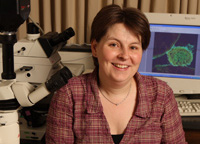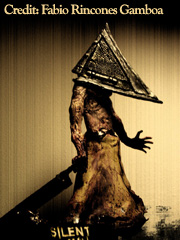Judith Thorn unearths humanoid origins with students
at Knox College
By Marsha E. Lucas

Gargoyle wings, elf ears, and a
mermaid tail fin are just a few of the anatomical
features studied by students in
Judith Thorn’s developmental biology class at
Knox College. These so-called humanoids offer a
creative way for students to apply their knowledge
of basic developmental biology. Thorn, an associate
professor at Knox, described this
humanoid project in a poster at the 2010 SDB
Annual Meeting for which she was awarded the
John Doctor Best Education Poster Award.
Students are asked to choose a
humanoid from fiction, film, television or video
games, and identify three of its distinguishing
characteristics. Based on their understanding of
human development, they are asked to describe the
cellular and molecular mechanisms that would account
for the development of those particular features.
Within this framework students are graded on their
writing, creativity, and ability to identify
relevant primary literature and then use it to make
a reasonable and logical argument for each
characteristic’s origins.
Popular humanoids studied in
Thorn’s class include vampires, dwarfs, and elves,
which she notes “come in all flavors.” There are
elves from Celtic literature, Tolkien’s elves,
Santa’s elves, and more. As a result, they have
many discussions on limb and outer ear development.
“Outer ear development is not
real hot on my list of things to know…I’m a
Xenopus early developmental biologist,” Thorn
said. “Once you have a spinal cord—I’m good.” Nonetheless, she’s learned a lot about outer ear
development from Shrek and other creatures in her
class.
The inspiration for Thorn’s
humanoid project came years ago while she was a
teaching assistant in Albert Harris’ vertebrate
embryology class at the University of North
Carolina. During a lesson on germ layers and their
derivatives, Thorn and Harris joked about how it
might be different if they were talking about
Klingon hearts. Klingons are a Star Trek warrior
species that possess an eight-chambered heart. “I
don’t know that they necessarily bought into it as
part of lecture, but it amused us considerably,”
Thorn said.
Thorn joined the faculty at
Knox College in 2000 and began teaching
developmental biology. As time went by she began to
think that this humanoid project might be a way to
engage students and get them to apply their
knowledge to something they were really interested
in. It would also be a way to review course
material for the final exam.
Prior to turning in their
three-page papers, students give 10-minute talks on
their chosen humanoid and the development of its
unique characteristics. They get feedback on their
logic and justification from the class and can then
address any issues in their paper. All of the
student’s papers are placed in the library on
reserve so the entire class can use them to study
for the final exam.
 For Thorn, creativity and
originality matter. She hopes students will produce
scholarly work that can be submitted into Knox’s
literary journal,
Catch, as science fiction. One former
student, Andrew Prendergast, wrote a particularly
entertaining piece (pg. 84) on
Pyramid Head, a monster from the Silent Hill
video games with a “tetrahedral metal helmet” head
and a propensity toward violence. Prendergast
cleverly writes it “almost like a psychological case
study,” Thorn said. “But, the developmental biology
was excellent and well strung together.” For Thorn, creativity and
originality matter. She hopes students will produce
scholarly work that can be submitted into Knox’s
literary journal,
Catch, as science fiction. One former
student, Andrew Prendergast, wrote a particularly
entertaining piece (pg. 84) on
Pyramid Head, a monster from the Silent Hill
video games with a “tetrahedral metal helmet” head
and a propensity toward violence. Prendergast
cleverly writes it “almost like a psychological case
study,” Thorn said. “But, the developmental biology
was excellent and well strung together.”
Since implementing the humanoid
project in 2006, “students reviewed the activity as
a good one, as one that they enjoy and that they can
invest in,” Thorn said. Although a goal of this
project was to help students better understand the
course material, “I can’t say they’re doing better,”
she said. “But, I can say they appear to like it
more.”
While much of her time is
spent teaching, Thorn is still able to do some
developmental biology research of her own. She
studies the role of the endocytic protein,
Intersectin, in early Xenopus development.
Recent work with an undergraduate senior Honors
student suggests it is required for gastrulation.
One of the advantages to
working at a small liberal arts college with a small
biology department, is that it has impelled Thorn to
interact with faculty from other disciplines. She
has collaborated with both an animal behaviorist and
clinical psychologist to publish interdisciplinary
research with undergraduate students.
One of Thorn’s diverse
interests is dog training. As a graduate student at
UNC, she used the money she won from a teaching
award to adopt a shelter dog. “If you helped with
[dog training] classes [at the shelter], you could
take classes for free and so I was an assistant,”
she said. With this expertise, Thorn has
collaborated with Jennifer Templeton, a faculty
member in the Knox biology department who studies
learning and cognition in birds, to study learning
in dogs.
Thorn credits SDB with helping
her maintain her interest in developmental biology.
The Society supported her participation in the first
Faculty Re-Boot Camp in San Francisco, offered
travel awards to regional and national meetings, and
has “just been nice to myself and my students,” she
said. “I know from having been to other societies
that not everybody is necessarily as welcoming to
teaching faculty and to undergraduate students as
SDB is.”
Thorn really enjoys the work
she is doing at Knox. “I love to teach,” she said.
“I think that most of the time the best day teaching
is better for me than the best day at the bench.
That being said, the more bench stuff I get to work,
the more exciting that is too. ...They’re a nice
complement.”
A description of the humanoid
project and rubric can be found on Thorn’s website
at
http://departments.knox.edu/Humanoids. Examples
of some of her student’s work can be found on the
Catch website at
http://departments.knox.edu/catch/2009sp/roy-perspective.pdf.
|